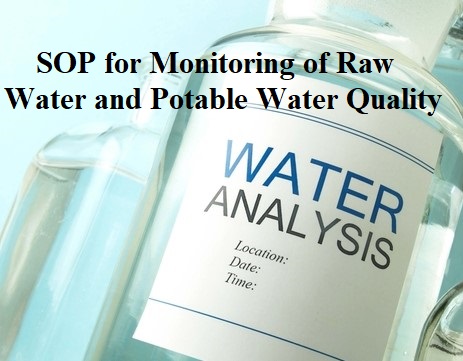
Raw water refers to water in its natural state, as it exists in a river, lake, or aquifer, SOP for Monitoring of Raw Water and Potable Water Quality without any treatment or purification. Potable water, on the other hand, is water that is safe for human consumption and meets health and quality standards set by regulatory agencies. Potable water typically undergoes treatment processes, such as filtration, disinfection, and removal of impurities, It is important to note that drinking raw water carries health risks, as it may contain pathogens, contaminants, and other harmful substances that can cause illness or disease. Potable water, on the other hand, is treated and tested to reduce these risks and provide a safe source of drinking water
OBJECTIVE
To lay down a procedure for monitoring of raw and potable water quality.
SCOPE
This procedure is applicable for monitoring of raw and potable water quality.
RESPONSIBILITY
Executive/Officer – Quality control
ACCOUNTABILITY
Manager – Quality Control
PROCEDURE
Preparation of sample containers for microbiological analysis.
- Take clean and dried screw cap/stopper 300 ml bottles wrap with aluminum foil /butter paper securely with a rubber band for raw and potable water separately SOP for Monitoring of Raw Water and Potable Water Quality.
- Add one ml of 5 % solution of sodium meta bisulphate to each bottle used for sampling of chlorinated water.
- Sterilize the bottles for 30 minutes at 121°C & 15 psi.
Collection of raw/ potable microbiological and chemical analysis.
- Collect sterile bottles for microbiological sampling.
- Select the user point for sampling.
- Before collection of sample for potable water. Open the valve tap and allow the water to drain for one minute.
- Hold sterile bottle near the sampling point or at the hose, unwrap the aluminum foil/ butter paper and open the bottle, taking care not to touch the stopper or neck of the bottle
- Collect raw water sample approx. 250 ml in the sterile bottle.
- Wrap the neck of the bottle with same aluminum foil /butter paper to avoid any contamination.
- Collect about 900 ml of raw water with rinsing in previously clean 1000 ml capacity bottle for chemical analysis. Close it with stopper.
- Wipe the bottle dry from outside and label them with following details
- Name of the sample
- Collection point
- Date/Time of collection
- A/R No
- Sampler’s signature
- Bring the sample to Quality Control Laboratory enter the Details in Raw /Potable water register.
Analysis of potable water /raw water
- Perform the microbiological analysis of potable water/raw water
- Microbiological analysis as per SOP for water analysis.
- Perform the analysis of water sample within an hour of sampling.
- If analysis cannot be done within one hour of sampling, keep the sample at 2-8 °C, in such case analysis shall be done within four hours after sampling SOP for Monitoring of Raw Water and Potable Water Quality.
- Perform the test for total bacterial count and presence of the pathogen.
- Record the result of microbiological analysis of potable water register as per format.
- In case of sample fails in testing, Instruct production personnel to stop the use of potable water.
- Resample the water.
- Investigation shall be done involving production and QA manager to identify the reason for failure if the sample fails and to take the corrective action.
- Collect the fresh sample after corrective action perform complete testing
Chemical analysis of raw water
- Perform the chemical analysis of water as per standard testing procedure.
Interpretation of alert and action limit for microbiological testing. - If the total bacterial count exceeds the alert limit i.e. 300 cfu/ml then alert the production and engineering department to investigate the probable cause.
- If the total bacterial count exceeds the action limit i.e. 400 cfu/ml or fails in pathogens then immediately stop the use of water and resample the potable water from the particular user point, SOP for Monitoring of Raw Water and Potable Water Quality.
- Inform the production personnel/personnel department to stop the use of potable water and the water system shall proceed for the cleaning and sanitization.
Perform the analysis of resampling.
- A thorough investigation involving quality assurance manager and production manager shall be done (Refer Annexure-I)
- After the sanitization of the loop, collect the sample from all user points.
- Perform the analysis of all samples collected from user points.
- If the resample and /or subsequent samples after sanitization shows a total bacterial count of more than 400 cfu/ml or presence of pathogens then investigate thoroughly for probable cause of failure and corrective action shall be taken.
- Resample from all user points, subsequent to corrective action(s) performs the complete analysis. If the sample collected, subsequent corrective action(s) comply with the test then the use of potable water shall be restarted.
- If the presence of pathogenic organism is detected in the fortnightly sample then follow the procedure similar to that if followed for the total bacterial count, as described above (5.4)
- If the sample or the subsequent samples after sanitization comply with the test for pathogens then the water system shall be restarted
- In case resample confirms the presence of any of the pathogenic organisms, then the investigation shall be extended to finished product in which the water has been used
- Details of user points.
- Prepare the final testing report.
Frequency of testing
- Every one user point using SCDA media. Once in 15 days test for TBC and pathogen to be perform
- Related: Sanitization of RO Membranes in Purified Water System

